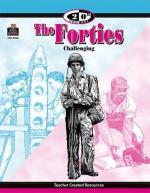|
This section contains 1,187 words (approx. 4 pages at 300 words per page) |

|
When the 1940s began, phonograph records were limited to albums that played at 78 rpm (revolutions per minute). Besides the fact that these records could hold only four minutes of music per side, they were made of shellac and thus scratched and broke easily. By the end of the decade, however, phonograph technology had improved dramatically. In 1948 Columbia Records introduced the vinyl long-playing record (LP), which was more durable, provided better sound reproduction, and could hold nearly twenty-five minutes of music per side On the heels of the 33 1/3 rpm LP came the rpm record, introduced by RCA Victor, which could record only as much music as a 78 rpm record but shared the improvements offered by the LP. Such developments were a boon to the jukebox, which had first gained popularity in the 1930s. With the use of 45 rpm records, its survival was ensured...
|
This section contains 1,187 words (approx. 4 pages at 300 words per page) |

|




